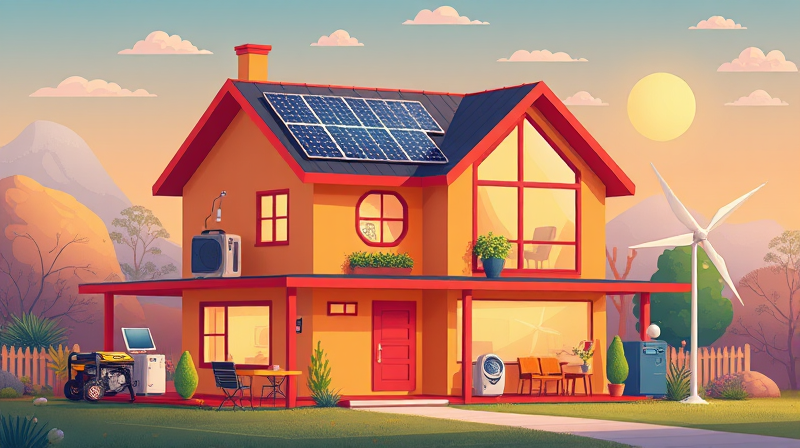In today's rapidly evolving world, making the best use of household resources to generate and conserve power is not only a smart move financially but also an inspiring way to embrace innovation and sustainability. With a little creativity and determination, anyone can transform everyday items and simple modifications into practical energy solutions.
The concept of generating power at home takes a back-to-basics approach where common items can be repurposed into tools for renewable energy. This article provides insight into several effective methods to harness energy from readily available household resources. By exploring ideas like building simple generators, harnessing solar energy, implementing energy-saving measures, utilizing heat pumps, and even exploring wind and biomass systems, homeowners can adopt a more energy-efficient lifestyle.
The DIY Generator: A Creative Approach to Energy Generation
One of the most accessible projects to kick-start your journey to energy independence is creating a simple generator. This project involves building a basic electrical generator using items you might already have. The fundamental principle at work is electromagnetic induction, which is at the heart of many modern technologies.
- Materials: Cardboard, a large iron nail, a bolt with a nut, enameled copper wire, a button magnet, a small light bulb and its holder, and insulating tape form the basic building blocks.
- Steps: Begin by winding the copper wire around the nail, secured between two cardboard pieces. Connect the ends of this coil to the light bulb holder. Then, attach the button magnet to the bolt and fix it using a hand drill. By bringing the spinning magnet near the nail head and operating the drill, you generate electricity that can light up the small bulb.
This project not only emphasizes the importance of understanding basic physical principles, but it also serves as a stepping stone to appreciate more complex renewable energy technologies. It shows that power can be generated with simple components and everyday items, making it an inspiring way to reduce dependency on the grid.
Exploring DIY projects cultivates skills in innovation, creativity, and problem solving essential for tackling bigger challenges in energy management. Embracing such projects at home provides a rewarding experience while offering practical benefits.
The approach demonstrates that with minimal investment in materials, one can generate visible and direct results. These small successes pave the way for more ambitious renewable energy projects and a future where household energy independence is within reach for everyone.
Innovation shines through when individuals create solutions using available resources. Homeowners adopting such practices not only enjoy reduced energy bills but also contribute to the collective efforts of sustainable development.
Sustainability through solar energy offers another accessible opportunity. Installing photovoltaic panels or utilizing solar water heating systems can dramatically reduce reliance on traditional power grids. The potential to cut energy bills while simultaneously reducing environmental impact makes solar power an inspiring choice for homeowners.
Photovoltaic panels, often installed on rooftops, capture sunshine and convert it into electricity. Solar thermal collectors are equally effective, focusing on harnessing the sun's heat to warm water. With such simple yet powerful systems in place, even a basic household can become a mini power station.
Energy-saving measures also play a crucial role. Sometimes, the best way to gain power is by saving it. By reducing the overall energy usage in a home, the effective power available increases. Switching to LED lighting, unplugging appliances when not used, using programmable thermostats, and running heavy appliances during off-peak hours can accumulate to significant savings.
This approach not only benefits personal finances but also supports a broader environmental cause. When homeowners make these small adjustments, the overall energy demand decreases, leading to a more efficient energy network and a healthier planet.
Heat pumps, wind energy, and biomass systems further diversify the options available. Air source heat pumps are especially effective in extracting ambient energy from the environment, providing both heating and cooling solutions. For those with appropriate climates and space, small-scale wind turbines offer another renewable avenue, although local regulations and space requirements should be considered carefully.
Biomass systems, on the other hand, rely on natural organic materials to produce heat and power. While this may not be applicable for every household, it remains a viable option in areas with plenty of organic waste or agricultural by-products. The creative use of biomass extends the boundaries of renewable energy and enriches the diversity of sustainable practices available for home energy management.
Lastly, the integration of smart home technology into energy systems transforms how a household manages power. Smart thermostats, automated lighting, and energy monitoring systems ensure that energy consumption is optimized. These technologies work by learning daily habits and adjusting power usage automatically to maximize efficiency. The simplicity of plugging into a smart ecosystem further empowers homeowners to achieve energy independence while living in a modern, connected world.
Through combined efforts in both energy generation and conservation, households can make remarkable strides towards power efficiency. This journey of transforming an ordinary home into a powerhouse of renewable energy is filled with opportunities for learning, innovation, and significant cost savings. Taking control of your energy consumption is not merely a technical challenge—it is an empowering lifestyle change that contributes to a sustainable future.
Ultimately, these methods demonstrate that every home has the potential to be a source of inspiration and power. With ingenuity and the right approach, you can harness the energy all around you, lower your bills, and contribute to a greener planet. Embrace these ideas, experiment with small projects, and let your household become a beacon of sustainability and innovation.








